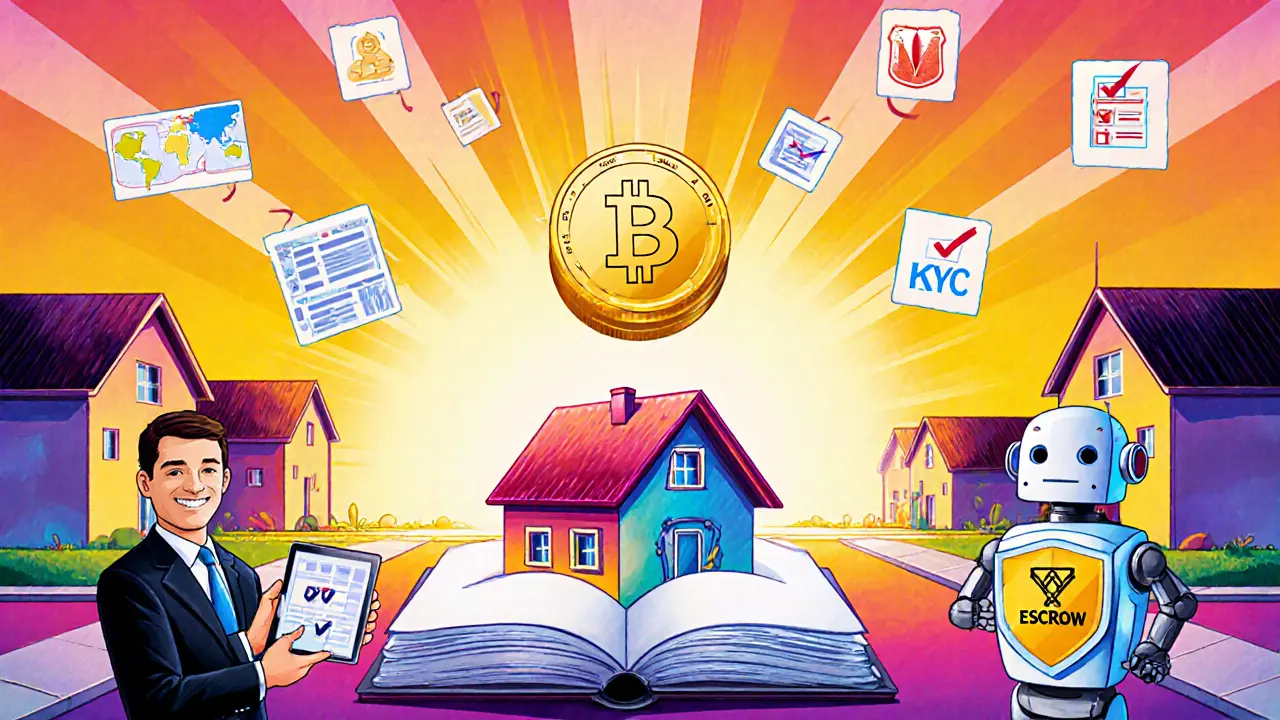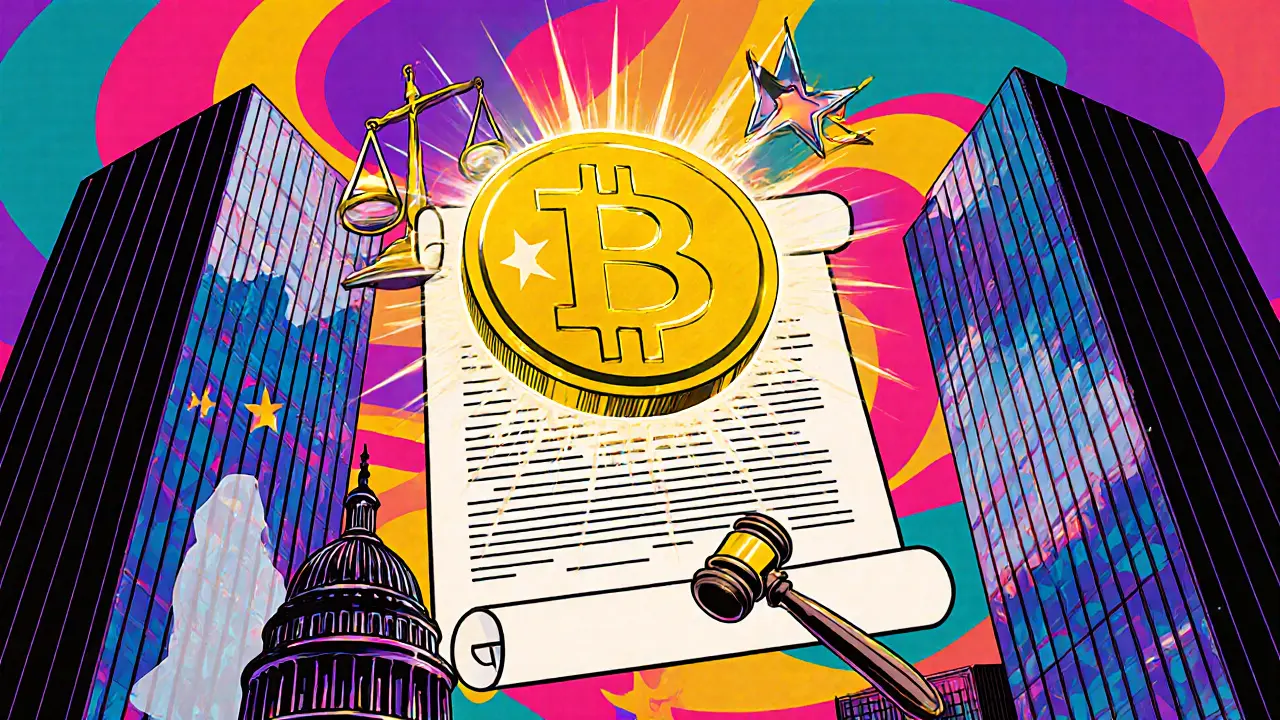Real Estate NFT Compliance Cost Calculator
Calculate Your Compliance Costs
Compliance Cost Breakdown
Compliance costs can vary significantly based on jurisdiction and specific requirements. Values shown are estimates based on industry data.
Key Takeaways
- Regulatory frameworks for real estate NFTs differ wildly across jurisdictions, creating uncertainty for issuers and investors.
- Most major economies still lack clear definitions-many treat tokens as securities, commodities, or even property deeds.
- Compliance costs (KYC/AML, legal counsel, licensing) can add 15‑25% to project budgets.
- Countries with blockchain‑native land registries (e.g., Sweden, Georgia) provide the smoothest path to adoption.
- Investors should prioritize platforms that use multi‑signature wallets, reputable escrow services, and transparent smart‑contract audits.
When we talk about real estate NFTs, we’re looking at a fast‑growing niche where property deeds or fractional shares are minted as non‑fungible tokens on public blockchains. The promise is simple: cut out middlemen, speed up transfers, and let anyone buy a slice of a skyscraper from their phone. But the promise collides with a maze of rules that differ from one country to the next. In this guide we break down the biggest regulatory pain points, why they matter, and practical steps you can take whether you’re a developer, an investor, or a traditional real‑estate professional trying to dip a toe into blockchain.
Real Estate NFTs are tokenized representations of physical or virtual property rights recorded on a blockchain, enabling fractional ownership, automated royalty distribution, and peer‑to‑peer trading without traditional intermediaries. They can be built on Ethereum, Polygon, Solana, or other networks, each bringing its own cost and speed profile. While the technology emerged after the ERC‑721 standard debuted in 2018, the first headline‑making deals only appeared in 2021. Since then, the market has exploded alongside the broader NFT boom, yet regulatory uncertainty remains the biggest roadblock to mainstream adoption.
Why Regulators Care: Property Rights Meet Digital Assets
At its core, a real‑estate NFT is a digital claim to a real‑world asset. Governments have spent centuries defining who can own land, how ownership is transferred, and how taxes are assessed. Introducing a blockchain token into that mix forces regulators to answer three questions:
- Is the token a security, a commodity, or a property deed?
- Does the smart contract satisfy consumer‑protection and anti‑fraud rules?
- How do anti‑money‑laundering (AML) and know‑your‑customer (KYC) obligations apply?
Answers vary. The U.S. SEC has already classified several token‑sale offerings as unregistered securities, leading to shutdowns like the TokenHomes collapse in March 2025. The EU’s Markets in Crypto‑Assets (MiCA) regulation, in force since December 2024, forces transparency but leaves a gray area for real‑estate NFTs, causing roughly 45 % of projects to be unsure of their classification. Meanwhile, the UK’s FCA is debating whether existing intellectual‑property and consumer‑protection statutes can be extended to cover NFTs.
Fragmented Global Landscape
Below is a snapshot of how major jurisdictions treat tokenized property today:
| Region | Legal Classification | Key Requirements | Adoption Rate |
|---|---|---|---|
| United States | Potential security | SEC registration or exemption, AML/KYC | 4.5 % |
| European Union | MiCA‑transparent asset, but ambiguous | White‑paper disclosure, AML, local interpretation varies | 6 % |
| Switzerland | Property token (D‑LT‑friendly) | Swiss Financial Market Supervisory Authority (FINMA) licensing | 19 % |
| Singapore | Security token under MAS | Fit‑and‑proper test, AML, custodial requirements | 14 % |
| China | Prohibited (cryptocurrency ban) | None - activity illegal | 0 % |
Notice the stark contrast: Switzerland and Singapore have clear pathways, while the U.S. and EU still wrestle with classification, and China outright bans crypto‑related activity. This patchwork forces token issuers to either limit themselves to compliant jurisdictions or build complex legal wrappers that can survive cross‑border scrutiny.
Core Compliance Challenges
Three recurring hurdles appear in every market study:
- Legal ambiguity: Without a universal definition, projects must hire local counsel in each target country, inflating costs by 15‑25 %.
- KYC/AML burden: Blockchain wallets are pseudonymous. Regulators demand identity verification, which adds 2‑3 days of onboarding time and requires integration with third‑party providers.
- Security classification: If a token is deemed a security, issuers face prospectus filing, ongoing reporting, and often a cap on who can invest (accredited investors only).
These factors explain why 30 % of new real‑estate NFT startups delayed launch in 2025, according to Landshare. The extra compliance layer also shrinks the pool of early adopters-only sophisticated investors with legal teams feel comfortable.
Technical Intersections with Regulation
Regulators don’t just care about legal language; they also audit the underlying code. Smart contracts that automatically distribute rent or trigger property‑title updates must be audited for bugs. A 2023 study recorded 37 major incidents in NFT marketplaces, 68 % of which were smart‑contract exploits costing $190 million total. Platforms that publish audit reports from firms like CertiK or ConsenSys are viewed more favorably by regulators and investors alike.
Interoperability is another practical issue. Most title registries remain offline, so bridging a blockchain token to a government land‑registry system often needs middleware, adding 15‑25 % to budgets (IntelMarketResearch, 2025). In jurisdictions where the land registry itself runs on blockchain-Sweden’s Lantmäteriet or Georgia’s national ledger-these costs disappear, making them hotbeds for pilot projects.
Practical Steps for Navigating the Regulatory Minefield
Whether you’re launching a platform or buying a fractional stake, follow this checklist:
- Jurisdiction first: Identify countries with clear token‑property laws (Switzerland, Singapore, Georgia, Sweden). Prioritize those for initial offering.
- Legal counsel: Engage a law firm experienced in both real‑estate and securities regulation. A dual‑expertise team reduces the risk of later re‑classification.
- Token classification: Conduct a formal assessment (e.g., Howey test in the U.S.) to decide if the token is a security, utility, or property deed.
- KYC/AML integration: Use vetted providers (Jumio, Onfido) and embed a 48‑hour verification window to keep transaction speed acceptable.
- Smart‑contract audit: Obtain a third‑party audit before launch, publish the report, and set up a bug‑bounty program.
- Escrow & insurance: Adopt multi‑signature wallets (68 % of institutional platforms use them) and consider decentralized insurance (e.g., Nexus Mutual) for up to 15 % coverage of token value.
- Disclosure document: Draft a white‑paper that outlines token economics, rights attached, risk factors, and the regulatory stance. Transparency reduces regulator‑initiated investigations.
Following these steps won’t guarantee a smooth ride, but it dramatically lowers the chance of a forced shutdown or costly legal battle.

Case Studies: Successes and Setbacks
Success - Wyoming, USA: In May 2025, a developer purchased a $450,000 single‑family home in Cheyenne using a blockchain deed recorded under Wyoming’s 2023 law that recognizes digital titles. The transaction closed in 72 hours, with no intermediary fees beyond the $3.50 Ethereum gas cost.
Setback - TokenHomes, USA: In March 2025, the SEC classified TokenHomes’ tokens as unregistered securities. The platform froze $8.7 million in investor funds and filed for bankruptcy, underscoring the danger of launching without a clear security determination.
Regional win - Georgia: Since 2018, Georgia’s national blockchain land registry has processed 1.2 million property transfers with zero fraud reports. The open‑source protocol has attracted over 50 foreign developers, making it a template for other emerging markets.
Future Outlook: Where Regulation Is Heading
Regulators are warming up to tokenized property. The European Central Bank’s 2025 pilot for cross‑border real‑estate NFTs across 12 Eurozone states aims to harmonize MiCA interpretations. The SEC is expected to release a detailed framework for real‑estate token classification in Q4 2025, which could give U.S. projects a clear path forward.
Industry groups like the Real Estate Blockchain Alliance (5,200 members) are lobbying for a “Digital Property Rights Directive” slated for 2026, which would establish a baseline definition for property‑linked NFTs across the EU. Gartner predicts that by 2030, 15‑20 % of commercial real‑estate deals will involve some form of tokenization-provided regulatory clarity improves.
Bottom Line
Regulatory challenges are the single biggest factor slowing the real‑estate NFT boom. The landscape is a patchwork of permissive havens and restrictive bans, and the legal classification of a token can change the entire business model. By focusing on compliant jurisdictions, securing expert legal counsel, and building transparent, audited smart contracts, participants can mitigate most risks and position themselves for the next wave of blockchain‑enabled property markets.
Do real‑estate NFTs count as securities?
In many jurisdictions, especially the U.S., regulators apply the Howey test. If the token offers profits from the efforts of others, it’s likely a security and must comply with securities law. The EU’s MiCA framework leaves room for interpretation, so local guidance is essential.
Can I buy a fractional NFT of a property in a country with strict crypto bans?
Practically no. Countries like China and Egypt prohibit crypto‑related activities, meaning any transaction involving a blockchain token would be illegal and subject to enforcement.
What are the biggest compliance costs for a real‑estate NFT platform?
Legal counsel across multiple jurisdictions, KYC/AML provider fees, and smart‑contract audit expenses typically add 15‑25 % to the overall project budget. Ongoing reporting for security‑type tokens can increase operational costs further.
Which blockchain networks are most used for real‑estate NFTs?
Ethereum leads with about 65 % market share, followed by Polygon (22 %) and Solana (8 %). Polygon offers lower gas fees, while Ethereum provides the widest ecosystem of tools and auditors.
How can investors protect themselves from smart‑contract bugs?
Choose platforms that publish third‑party audit reports, use multi‑signature wallets, and consider optional coverage from decentralized insurers like Nexus Mutual.

Write a comment